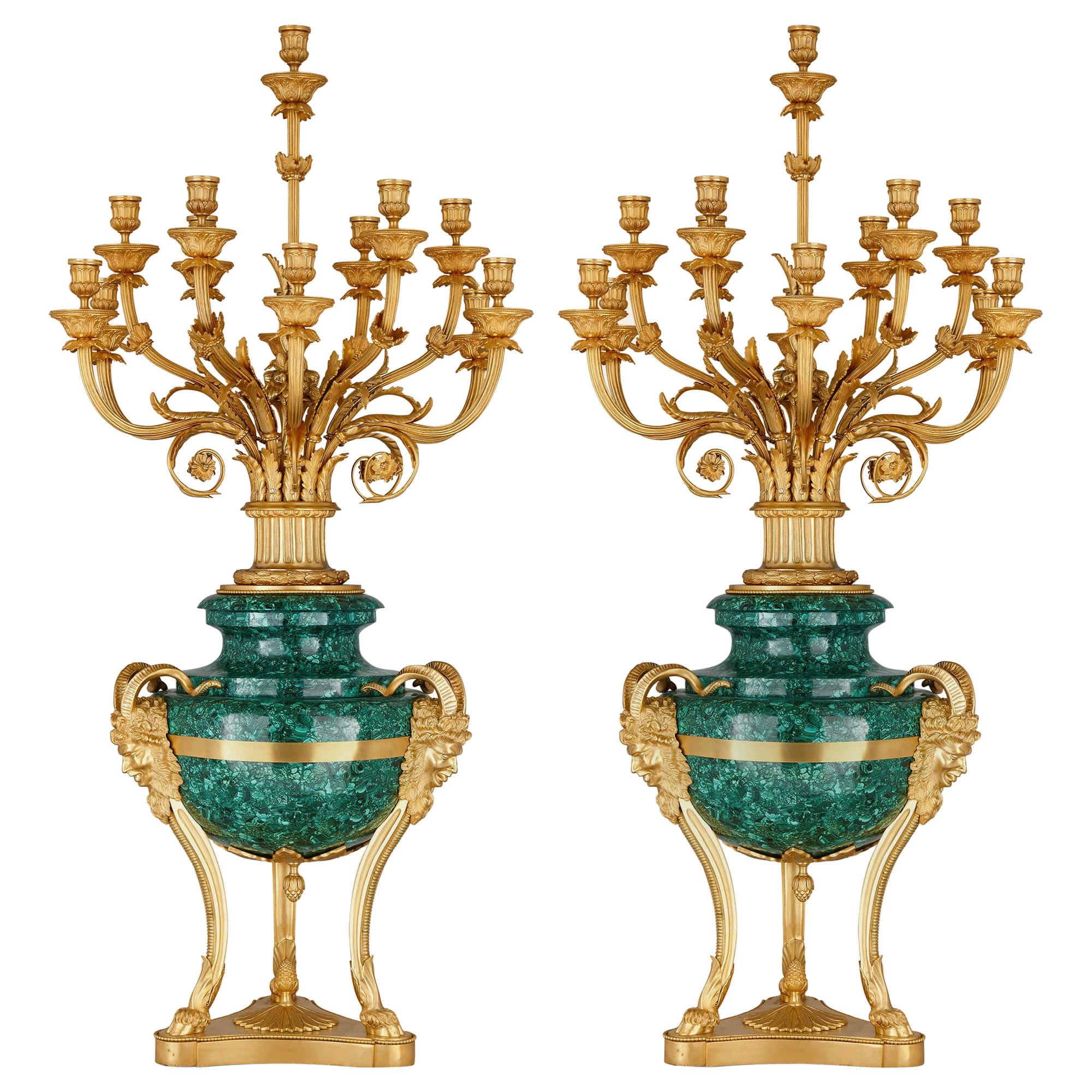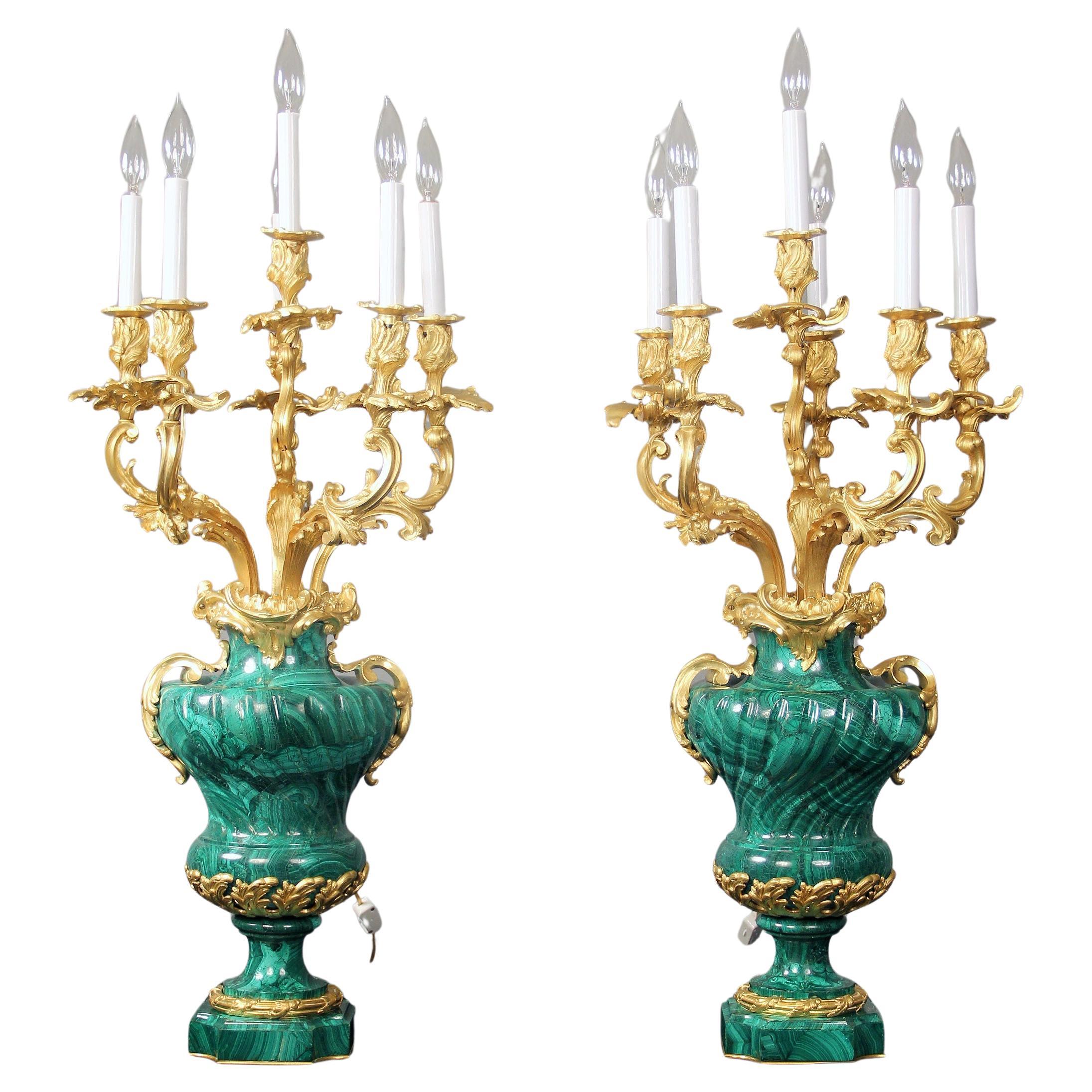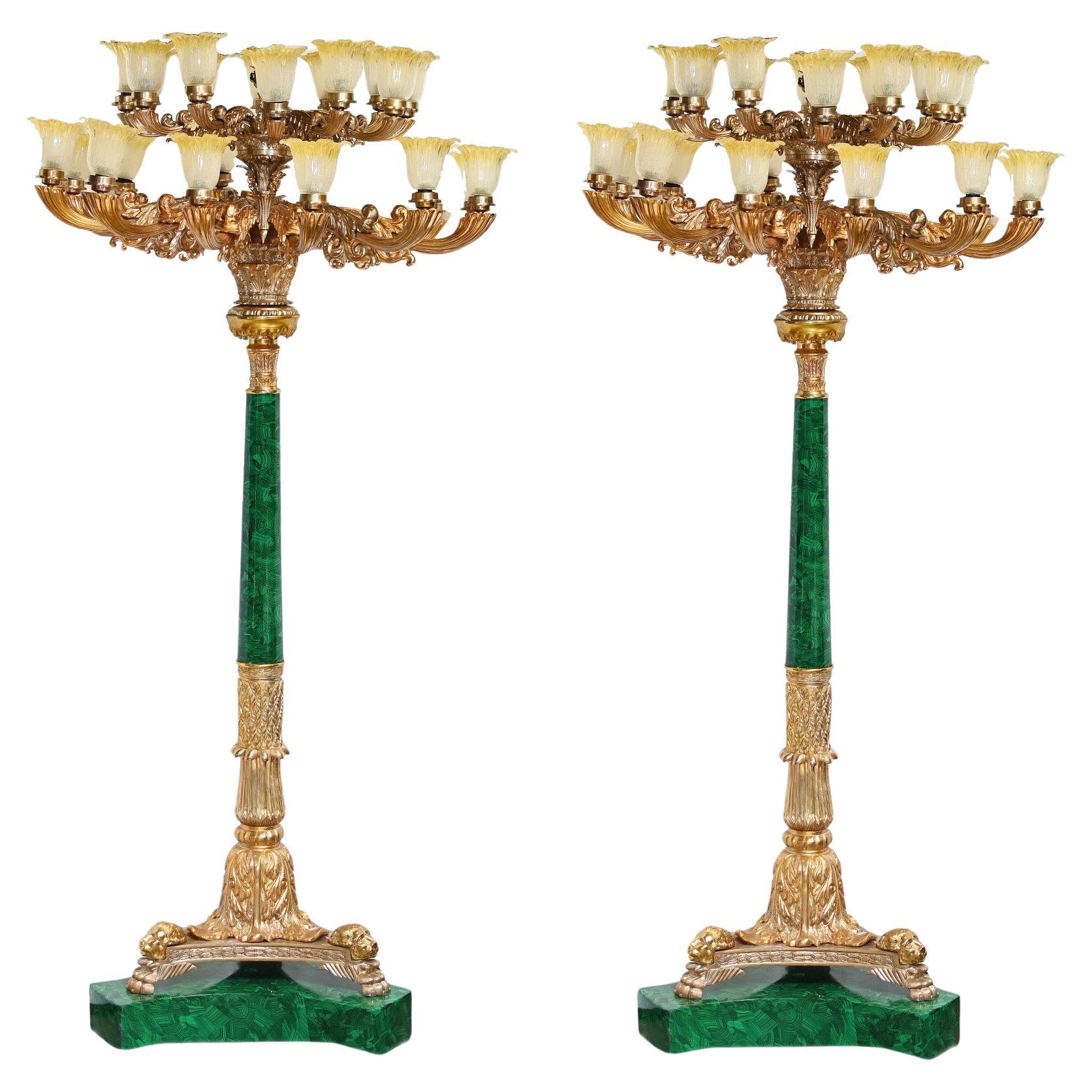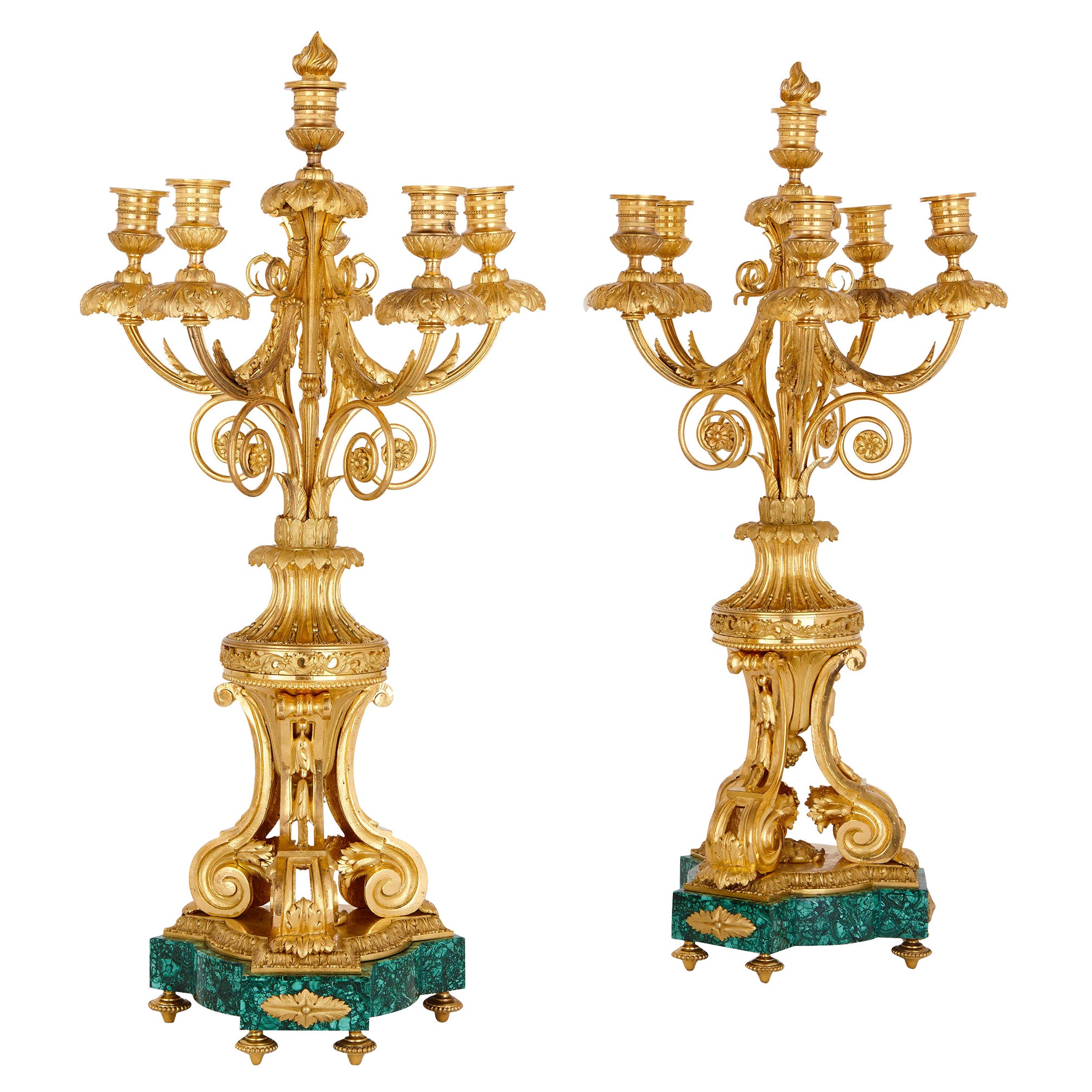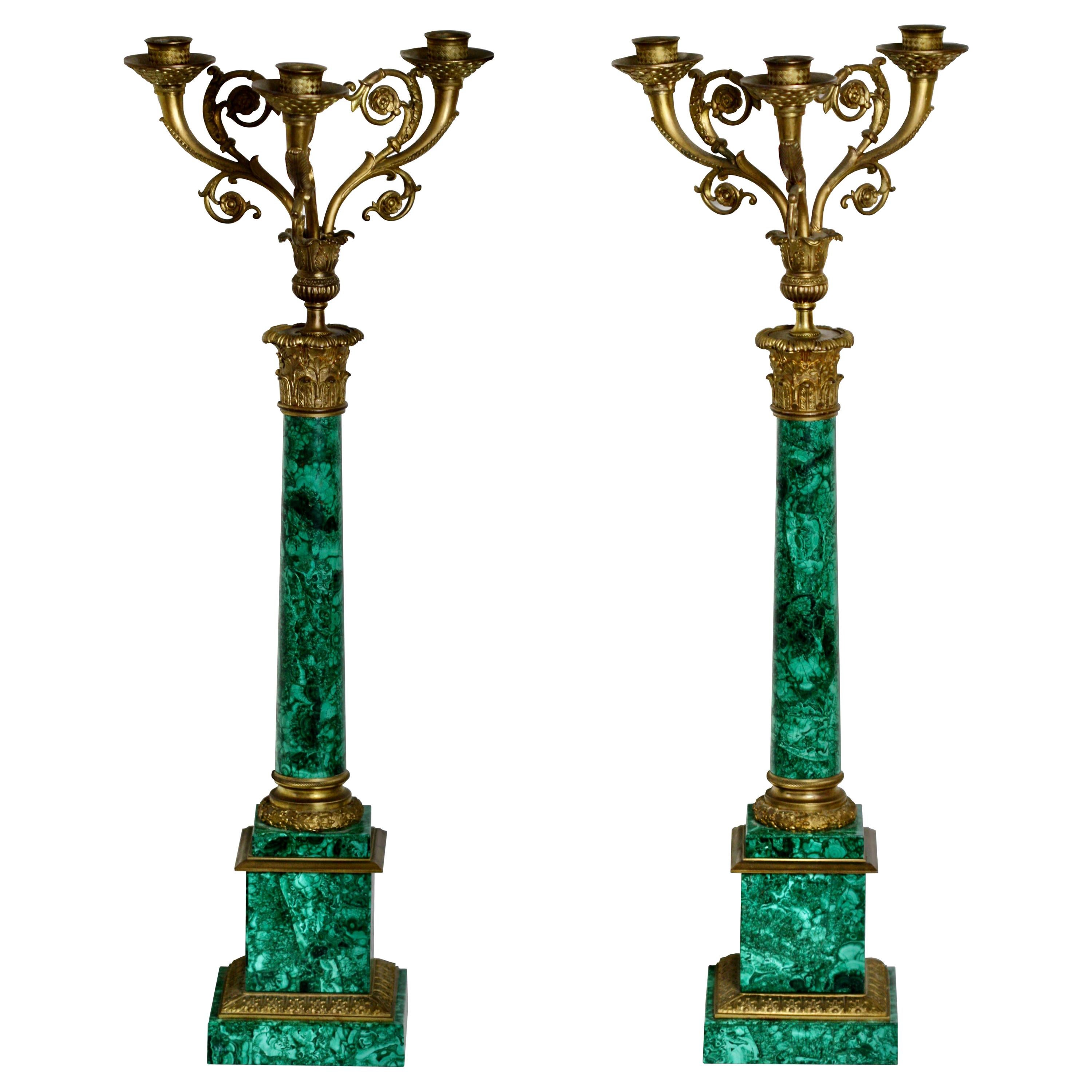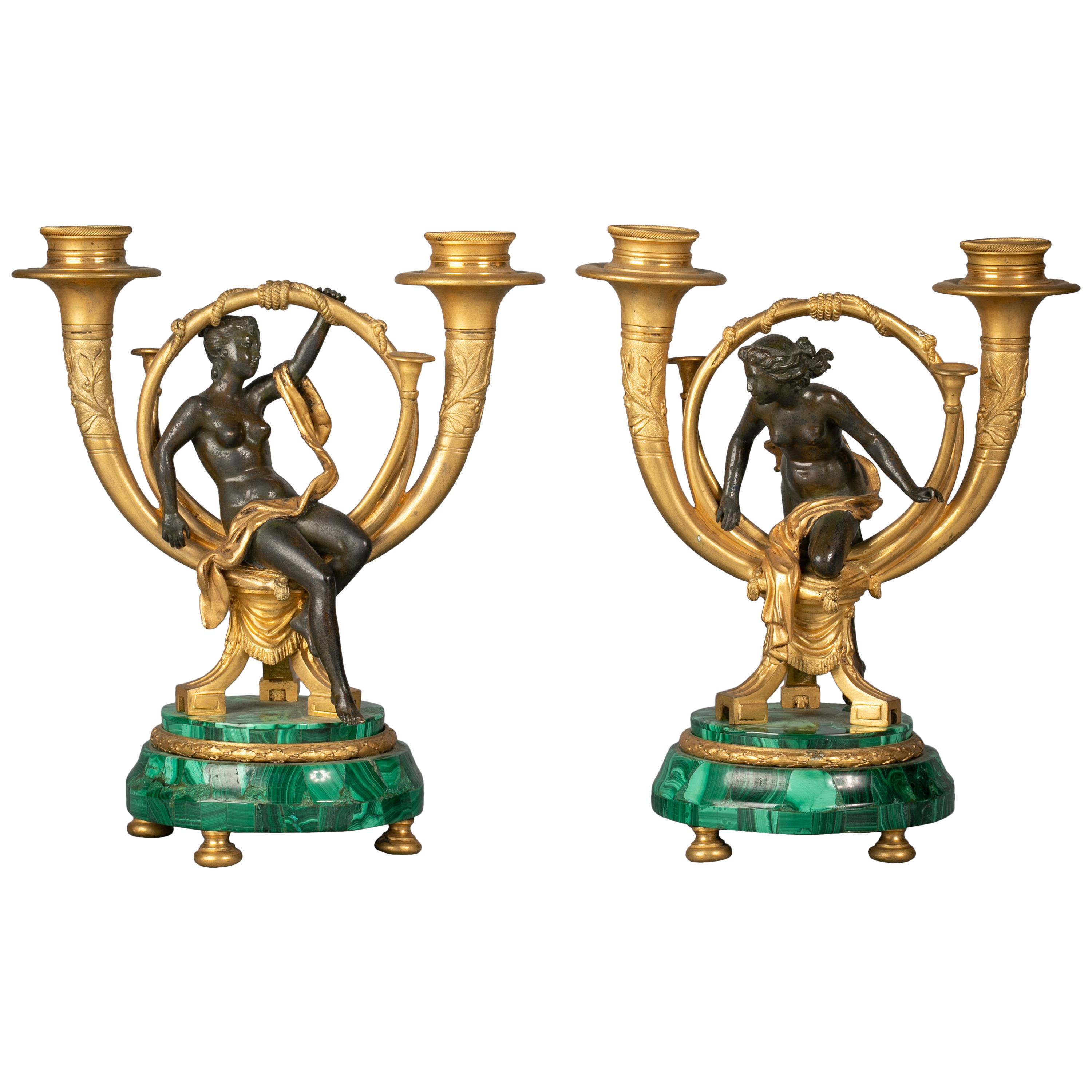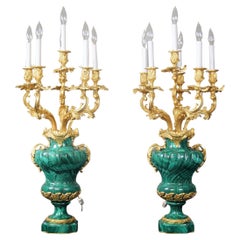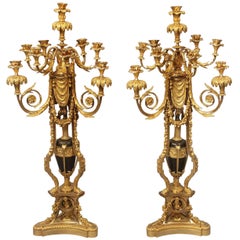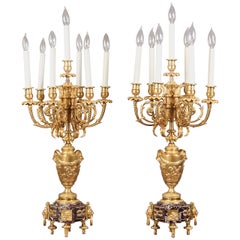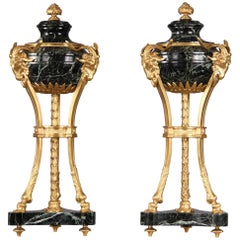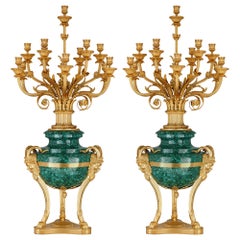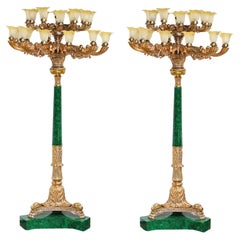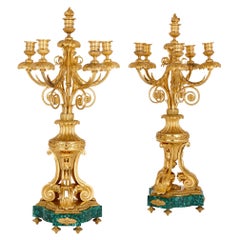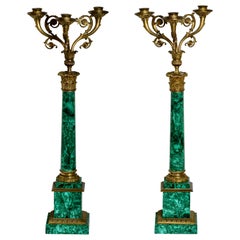Items Similar to Rare and Palatial Pair of Gilt Bronze and Malachite Seven Light Torcheres
Want more images or videos?
Request additional images or videos from the seller
1 of 8
Rare and Palatial Pair of Gilt Bronze and Malachite Seven Light Torcheres
$275,000per set
£207,650.50per set
€240,917.24per set
CA$386,461.40per set
A$430,572.55per set
CHF 224,779.24per set
MX$5,227,724.50per set
NOK 2,825,328.40per set
SEK 2,670,621.71per set
DKK 1,798,418.18per set
About the Item
A Rare and Palatial Pair of Mid 20th Century Gilt Bronze and Malachite Six Light Torcheres
The body of baluster form above a gilt bronze mounted circular and square base, the neck mounted with flowers and foliage leading up to seven tiered bronze acanthus arms.
Malachite is a semi-precious stone and also a valuable copper ore, hydrous copper carbonate. It is a beautiful green earth stone with irregular black banding. It is easily recognized by its color, green streak, and silky or velvety luster. It was used to make beautiful jewelry and to adorn only the finest pieces of furniture. In the 18th and 19th centuries malachite was popular with Russian Czars and Nobility. They often used it to decorate their palaces and own personal furnishings. The Hermitage Museum has one of the biggest and best displays of Malachite pieces in the world.
Details:
Height – 96 inches / 244cm
Width – 20 inches / 51cm
Depth – 20 inches / 51cm
- Dimensions:Height: 96 in (243.84 cm)Width: 20 in (50.8 cm)Depth: 20 in (50.8 cm)
- Sold As:Set of 2
- Style:Belle Époque (In the Style Of)
- Materials and Techniques:
- Place of Origin:
- Period:
- Date of Manufacture:circa 1950
- Condition:Refinished. Wear consistent with age and use.
- Seller Location:Long Island City, NY
- Reference Number:Seller: ES11stDibs: LU90567023573
About the Seller
5.0
Vetted Professional Seller
Every seller passes strict standards for authenticity and reliability
Established in 1924
1stDibs seller since 2010
85 sales on 1stDibs
Typical response time: <1 hour
Associations
The Art and Antique Dealers League of AmericaAntiques Associations Members
- ShippingRetrieving quote...Shipping from: Long Island City, NY
- Return Policy
Authenticity Guarantee
In the unlikely event there’s an issue with an item’s authenticity, contact us within 1 year for a full refund. DetailsMoney-Back Guarantee
If your item is not as described, is damaged in transit, or does not arrive, contact us within 7 days for a full refund. Details24-Hour Cancellation
You have a 24-hour grace period in which to reconsider your purchase, with no questions asked.Vetted Professional Sellers
Our world-class sellers must adhere to strict standards for service and quality, maintaining the integrity of our listings.Price-Match Guarantee
If you find that a seller listed the same item for a lower price elsewhere, we’ll match it.Trusted Global Delivery
Our best-in-class carrier network provides specialized shipping options worldwide, including custom delivery.More From This Seller
View AllPalatial Pair of Late 19th Century Gilt Bronze Mounted Malachite Candelabra
Located in Long Island City, NY
A Palatial Pair of Late 19th Century Gilt Bronze Mounted Six Light Malachite Candelabra
Finely casted gilt bronze and rococo and foliate arms above a spiraled carved malachite body with bronze handles, supported on thick square bases.
Malachite is a semi-precious stone and also a valuable copper ore, hydrous copper carbonate. It is a beautiful green earth stone...
Category
Antique Late 19th Century French Belle Époque Table Lamps
Materials
Malachite, Bronze, Ormolu
Exceptional Pair of 19th Century Gilt Bronze and Enamel Candelabra
Located in Long Island City, NY
An Exceptional Pair of Late 19th Century Napoleon III Gilt Bronze and Enamel Ten Light Candelabra
Attributed to Maison Beurdeley
The ten candle foliate designed branches with leaf drip pans, centered with an enamel vase and a gilt band with cherubs at play, topped with three bronze drapes and garlands of flowers. The triangle bases decorated with female masks and trailing floral motifs on plinth bases.
After the 18th century model by Pierre Gouthière.
This fine pair of candelabra are based on the model by Pierre Gouthière now conserved in the Petit-Trianon at Versailles. According to Pierre Verlet, the model corresponds to a large pair of candelabra with ten branches, drapery, foliage and fruit, richly carved and gilded in bronze, originally supplied by the marchand-mercier, Freres Darnault, for the Salon du Jeu de Mesdames at the Château de Bellevue.
Pierre Gouthière (1732 – 1813) was the most celebrated bronze gilder in France during the eighteenth century, the title of ‘Gilder to the King’ being given to him by Louis XV. He perfected the most expensive type of gilding of this period, dorure au mat, which involved the use of lavish amounts of gold to create a rich, deep matte finish. As well as working for the King he created items for the Comte d’Artois, the Marquis de Marigny, and the duc d’Aumont.
The collection of the duc d’Aumont was sold at auction in Paris in 1782 and many objects mounted by Gouthière were bought by Louis XVI and Marie Antoinette. His works, unsurpassed in creativity and execution, can now be found in the Wallace Collection and the Louvre.
Beurdeley, Louis-Auguste and Emmanuel-Alfred (1808-1882 and 1847-1919). The firm exhibited and won awards at all of the major international exhibitions during the second half of the nineteenth century. The quality and skill employed in production was of exceptional quality; their ormolu mounts with mercurial gilding and hand chasing were often difficult to distinguish from late eighteenth-century examples, and were considered the finest in Paris. The firm was pioneered by Jean Beurdeley (1772-1853), later managed by his son Louis-Auguste-Alfred, and finally imparted to his son Alfred-Emmanuel-Louis in 1875. The firm was established at 32 and 34, rue Louis-Le-Grand, and also owned the pavillion de Hanovre, where it was based while Alfred-Emmanuel-Louis added two additional workshops at 20 and 24, rue Dautancourt by 1875. The Beurdeley workshops closed in 1896, although still partially active until 1898 and the stock was sold over a number of auctions conducted by the Galerie Georges Petit of Paris. Two auction catalogues of the collection were published in 1895 and sales were held between March 6-8 and May 27-28.
Among Beurdeley’s most prestigious clients were Emperor Napoleon III and Empress Eugénie, the duc D’aumale, Richard Wallace, the Duc and Princess d’Hamilton, Tsarine Alexandra Féodorovna, The Rothschild and Vanderbilt dynasties and the Metropolitan Club...
Category
Antique Late 19th Century French Belle Époque Table Lamps
Materials
Enamel, Bronze
Fine Pair of Late 19th Century Gilt Bronze Seven-Light, Electrified Candelabras
By Claude Michel Clodion
Located in Long Island City, NY
A Very Fine Pair of Late 19th Century Gilt Bronze Seven Light Candelabra
After Claude-Michel Clodion
Each as a vase cast in high relief with a procession of putti, with a pair of g...
Category
Antique Late 19th Century French Belle Époque Table Lamps
Materials
Marble, Bronze, Ormolu
Pair of Late 19th Century Gilt Bronze Mounted Verde Antico Marble Cassolettes
Located in Long Island City, NY
A pair of late 19th century gilt bronze-mounted Verde Antico marble Cassolettes
Each with a removable lid, marble body surmounted with three bronze ram heads.
Category
Antique Late 19th Century French Belle Époque Urns
Materials
Marble, Bronze
Nice Pair of 19th Century French Gilt Bronze Mounted Chinese Canton Lamps
Located in Long Island City, NY
A Nice Pair of Late 19th Century French Gilt Bronze Mounted Chinese Canton Porcelain Lamps
Painted interior scenes with people at leisure, each separated by floral designs with butt...
Category
Antique Late 19th Century French Belle Époque Candelabras
Materials
Bronze, Ormolu
Pair of Late 19th Century French Gilt Bronze Mounted Chinese Porcelain Lamps
Located in Long Island City, NY
A Nice Quality Pair of Late 19th Century French Gilt Bronze Mounted Chinese Porcelain Lamps
Fine bronze mounts separate the six painted panels decorated with chinoiserie figures in ...
Category
Antique Late 19th Century French Belle Époque Table Lamps
Materials
Bronze, Ormolu
You May Also Like
Pair of Large Gilt Bronze and Malachite Neoclassical Style Candelabra
Located in London, GB
Pair of large gilt bronze and malachite neoclassical style candelabra
French, 20th century
Measures: Height 122cm, diameter 60cm
This large...
Category
20th Century French Neoclassical Floor Lamps
Materials
Malachite, Ormolu, Bronze
$60,625 Sale Price / set
20% Off
Pair Empire Malachite Gilt Torcheres Floor Lamps 8 Ft
Located in Potters Bar, GB
You are viewing an incredible pair of large Empire style floor lamps or torchieres
Hand crafted from gilt and faux malachite
The faux malachite is painted porcelain which looks very...
Category
Vintage 1980s Empire Floor Lamps
Materials
Paint
Antique Pair of French Neoclassical Style Gilt Bronze and Malachite Candelabra
Located in London, GB
Antique pair of French Neoclassical style gilt bronze and malachite candelabra
French, late 19th century
Measures: Height 62cm, width 30cm, depth 30cm
This fine pair of candelab...
Category
Antique Late 19th Century French Louis XVI Candelabras
Materials
Malachite, Bronze, Ormolu
$13,227 Sale Price / set
20% Off
Pair of Russian Style Gilt-Bronze Mounted Malachite Three-Light Candelabra
Located in West Palm Beach, FL
A pair of Russian style gilt-bronze mounted Malachite three-light candelabra
Fourth quarter of the 19th century
the round columns on a square plinth on bronze feet and issuing thre...
Category
Antique 19th Century Candelabras
Materials
Malachite
Pair of Unusual Gilt Bronze and Malachite Two-Light Candelabra, circa 1860
Located in New York, NY
Pair of unusual gilt and patinated bronze and malachite two-light candelabra, French, circa 1850
Both female figures within a double trumpet design sitting or kneeling on tasselle...
Category
Antique 1860s French Candelabras
Materials
Malachite, Bronze
Pair of 19th C. French Giltwood Emerald Green Opaline Crystal and Enamel Lamps
By Baccarat
Located in New York, NY
An incredible pair of 19th century French giltwood Emerald green opaline crystal and Enamel lamps, attributed to Baccarat. Each of these is made with the finest hand-cut French emera...
Category
Antique 1850s French Louis XVI Table Lamps
Materials
Crystal
More Ways To Browse
Lamps Black And Gilt Pair
Gilt Bronze Malachite
French Gilt Bronze And Malachite
Stone Balusters
Malachite Lamps
Lamp With Malachite
Green Malachite Lamp
Rembrandt Floor Lamp Brass
Ricardo Scarpa
Ron Mann
Ron Rezek On Sale
Serge Roche Torchere
Shiro Kuramata White Acrylic Ghost Lamp
Sottsass Moonlight
Sottsass Treetops
Stuart Ross James
Sumatra Lamp
Taliesin Lamp
